- Quick Read
- Deep Read ( 10 Min. )

Why is Christian Science in our name?
Our name is about honesty. The Monitor is owned by The Christian Science Church, and we’ve always been transparent about that.
The Church publishes the Monitor because it sees good journalism as vital to progress in the world. Since 1908, we’ve aimed “to injure no man, but to bless all mankind,” as our founder, Mary Baker Eddy, put it.
Here, you’ll find award-winning journalism not driven by commercial influences – a news organization that takes seriously its mission to uplift the world by seeking solutions and finding reasons for credible hope.
Explore values journalism About usIn Today’s Issue
- Was Jan. 6 the end of an era – or start of a dangerous new one?
- Afghanistan: Has Biden inherited defeat in America’s longest war?
- Teaching the Capitol riot is tricky. Especially if the teacher was there.
- World wonders whether Biden has enough bandwidth for it
- San Antonio educator: College-ready kids make poverty-proof adults
Monitor Daily Podcast
- Follow us:
- Apple Podcasts
- Spotify
- RSS Feed
- Download
TODAY’S INTRO
Character matters: No one elected to Baseball Hall of Fame in 2021
For the first time since 2013, not a single player garnered enough votes Tuesday to get into the National Baseball Hall of Fame this year.
Many awesome athletes were on the 2021 ballot, including Curt Schilling, Roger Clemens, and Barry Bonds. But none got into Cooperstown.
Perhaps, that’s a good thing.
When members of the Baseball Writers’ Association of America cast their votes each year, they’re not just taking into account performance on the field. The Hall of Fame voting rules require that writers also consider “integrity, sportsmanship, character.”
In recent years, many writers have refused to bestow the honor on excellent players who have had their careers tainted by accusations of steroid use, domestic abuse, and in Mr. Schilling’s case, for apparently endorsing a call to lynch journalists, among other off-the-field transgressions.
Some writers loathe this character clause. They don’t feel qualified to make such judgments. Others say the clause has been ignored for decades. ESPN’s Jeff Passan, who stopped voting in 2017, described Cooperstown as a “hill of hypocrisy” where “racists, wife beaters, drunks, gamblers and purveyors of manifold moral turpitude otherwise are celebrated.”
Yes, Hall of Fame voting rule No. 5 was often ignored in the past. But since the steroids era, many of today’s sports writers are now wrestling with this morality requirement. It’s not fun. It’s not easy. And maybe that’s the way it’s supposed to be.
Share this article
Link copied.

Help fund Monitor journalism for $11/ month
Already a subscriber? Login

Monitor journalism changes lives because we open that too-small box that most people think they live in. We believe news can and should expand a sense of identity and possibility beyond narrow conventional expectations.
Our work isn't possible without your support.
Was Jan. 6 the end of an era – or start of a dangerous new one?
To Americans weary of political tumult, Donald Trump’s departure from the White House came with hopes for renewed stability. Yet experts say the roots of radical extremism are deep. Solutions may require persistence.
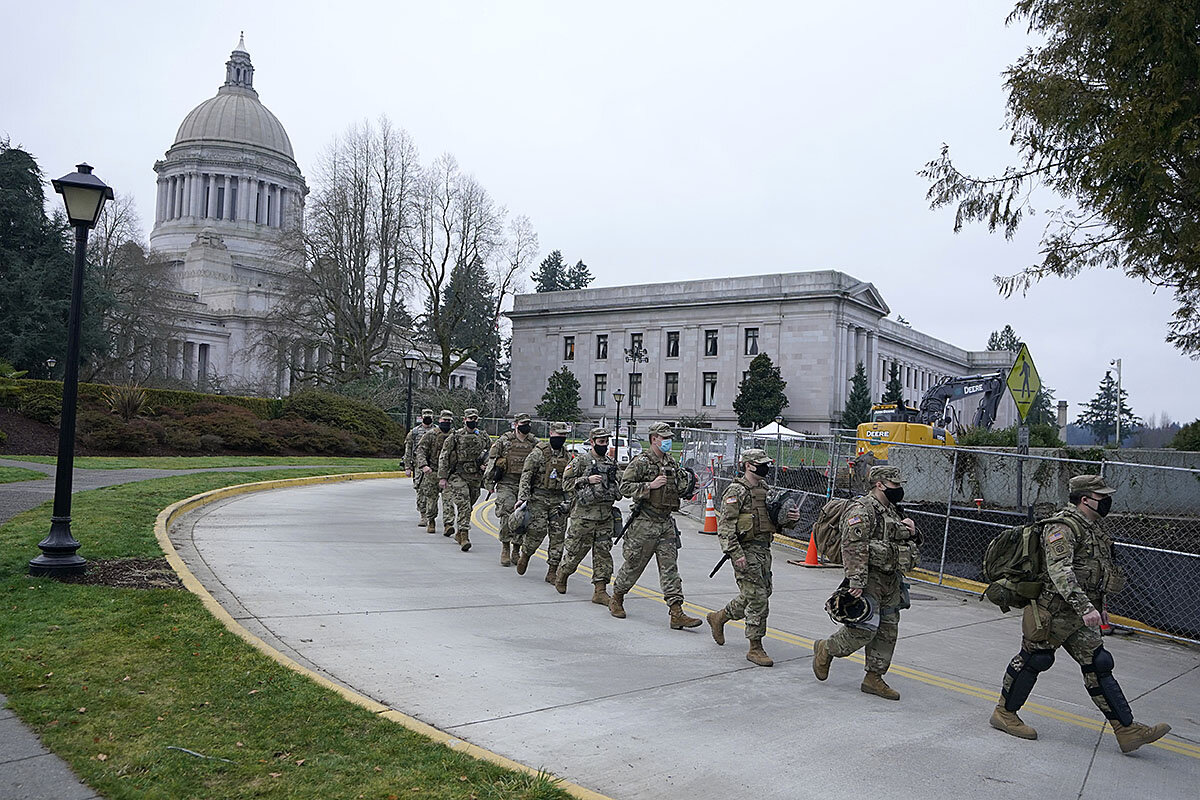
-
Patrik Jonsson Staff writer
-
Henry Gass Staff writer
The Capitol riot on Jan. 6 didn’t spring up in isolation.
From Oregon to Texas and Michigan to Washington, D.C., stark scenes of sometimes-violent protests and gun-toting militia groups have proliferated nationwide over the past year, underscoring the growing radicalization of extremist groups on both ends of the American political spectrum.
“The genie is out of the bottle,” says Chris Loftis, spokesman for the Washington State Patrol. “That genie had hid its face, but ... it is with us,” he says, “exposing to everyone how deep and dangerous our vulnerabilities are.”
Experts say solutions to radicalism will require persistent effort – even though the vast majority of Americans aren’t prone to political violence. New efforts to counter extremism are percolating, from vigilance by social media platforms to more robust steps by law enforcement and state legislators.
Twenty years after the foreign terrorist attacks of 9/11, Americans are waking up to a new era defined by the need to combat a more insidious and potentially damaging threat: the escalating spiral of homegrown radicalism in their own backyard.
Was Jan. 6 the end of an era – or start of a dangerous new one?
Hours after President Joe Biden’s heavily defended inauguration and call for national unity and civility, about 100 anti-fascist protesters, many hooded and clad in black, vandalized federal and corporate buildings in downtown Seattle, burning a large U.S. flag, smashing windows, and spraying graffiti with messages such as “kill ICE” and “abolish everything.” They also hurled abuse at the new president.
Meanwhile, 60 miles to the south, hundreds of right-wing, pro-Trump demonstrators – some of them armed – have staged protests this month outside the Washington State Capitol in Olympia. Angry about pandemic restrictions and an election they believe was stolen, they broke into the compound of the governor’s mansion on Jan. 6, and then returned five days later to the adjacent state capitol where they confronted hundreds of National Guard soldiers deployed there.
From Oregon to Texas and Michigan to Washington, D.C., stark scenes like this have proliferated nationwide over the past year, underscoring the growing radicalization of extremist groups on both ends of the American political spectrum.
The Jan. 6 storming of the Capitol in Washington exposed this ugly intolerance in graphic form. “The genie is out of the bottle,” says Chris Loftis, spokesman for the Washington State Patrol. “That genie had hid its face, but … it is with us,” he says, “exposing to everyone how deep and dangerous our vulnerabilities are.”
Indeed, 20 years after foreign extremists crashed planes into the Pentagon and World Trade Center, killing thousands and unleashing a global war on terrorism, Americans are waking up to a new, post-9/11 era defined by the need to combat a more insidious and potentially damaging threat: the escalating spiral of homegrown radicalism in their own backyard.
“The putsch attempt on January 6 was both the end of an era and the beginning of another one,” says Vasabjit Banerjee, a political scientist who studies contentious politics at Mississippi State University in Starkville and author of “Undoing the Revolution.”
But precisely what kind of end or beginning will this be?
To Americans who had grown weary of tumultuous politics over the past four years, Donald Trump’s departure from the White House comes with hopes that some stability will return in the nation’s capital and beyond.
Mr. Biden has made national healing and unifying the overt goal of his presidency. And new efforts to counter extremism are percolating, from vigilance at social media platforms to more robust steps by law enforcement and state legislators.
Yet experts say solutions to radicalism require persistent effort – even though the vast majority of Americans aren’t prone to political violence.
Outside the gold-domed Georgia Capitol in Atlanta, where dozens of desert-fatigued military police stood guard against a potential attack by pro-Trump forces on Jan. 18, church leader Nina Polk voices a blend of concern and cautious hope.
This moment, she hopes, marks the beginning of an era where the country begins to wrestle in earnest with fundamental divides and pain that have been fueled by disinformation, online hatred, and tribal politics. In fact, she has led a flock from her congregation on a mission to ease tensions.
“A kingdom divided against itself can’t stand,” she says as she takes in the surreal scene of a state capitol barricaded against assault amid a transfer of presidential power in Washington.
Recipe for insurgency?
Last month, a North Carolina man and self-described member of the Boogaloo Bois – one of the violent right-wing extremist groups involved in attacking the Capitol – pleaded guilty to conspiring with the foreign terrorist organization Hamas to blow up a courthouse in Minnesota.
The man, Benjamin Ryan Teeter, belonged to a Boogaloo Bois subgroup called the “Boojahideen.” He and a co-defendant allegedly offered to work as mercenaries for Hamas and provide material support in plots to destroy U.S. government buildings and attack U.S. soldiers overseas.
Such actions – along with increasingly brazen threats and attacks against public officials – signal how loosely connected groups of individuals appear to be advancing beyond “domestic terrorism” toward the earliest stage of an insurgency, experts say. (The word “boogaloo” in these circles refers to an impending second U.S. civil war.)
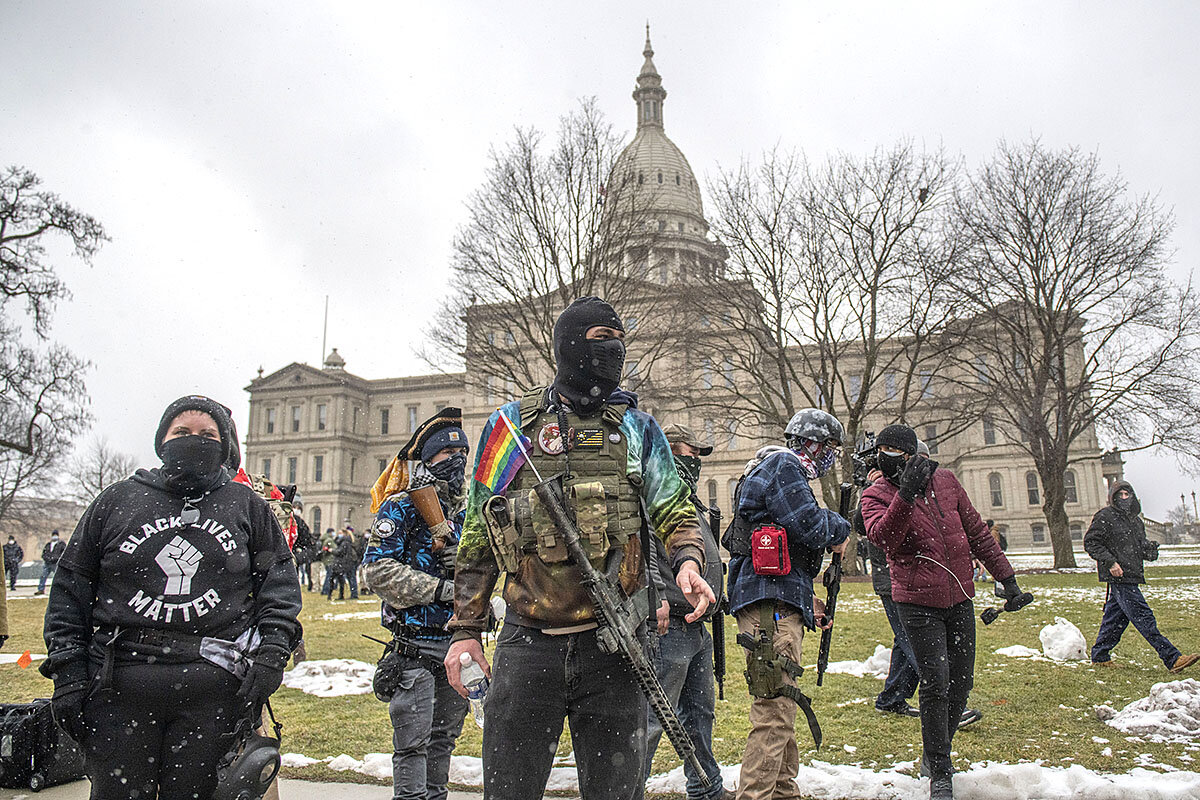
“This is not going away anytime soon,” predicts retired Col. Lawrence Wilkerson, a fellow at the Quincy Institute, who helped war-game the possibility of violent disruptions to the 2020 election with the Transition Integrity Project.
On Wednesday, the acting secretary of Homeland Security issued an alert on domestic terrorism risks in the weeks ahead, from “extremists with objections to the exercise of governmental authority and the presidential transition, as well as other perceived grievances fueled by false narratives.”
Rooted in white supremacy, right-wing extremist groups and militia are increasingly recruiting from within U.S. military and law enforcement ranks and also communicating with neo-Nazi and other like-minded groups overseas, Colonel Wilkerson says. And they are seeking followers from the ranks of millions of disappointed supporters of former President Trump.
The ground for such recruiting has become more fertile due to a range of trends affecting America well before Mr. Trump launched his presidential campaign. These include feelings of economic and cultural dislocation in an era of rapid change, growing distrust of institutions, and the rise of social media and increasingly partisan news outlets. The result, alongside populism, has been a growing prospect of violence at the fringes.
The United States faces an “incipient insurgency,” says David Kilcullen, a counterinsurgency expert, retired military officer, and professor at Arizona State University. This stage involves disparate groups growing more organized, training, building public and external support, and waging more coordinated anti-government attacks.
“You may have several simultaneous proto-insurgencies all happening at the same time, sponsored by different groups, and it’s often impossible to determine which, if any of those, will progress to a more serious stage,” Mr. Kilcullen said in an interview this month on WBUR.
Extremists’ growing presence
The problem risks expanding beyond domestic terrorism, which has surged in recent years, even as the nation focused most of its resources on international terrorism. Federal prosecutions classified as domestic terrorism hit a record high last year. “Domestic terrorism and the far-right aspect of terrorism is now the greater threat to the homeland,” says Javed Ali, a former senior director of counterterrorism at the National Security Council.
The Biden administration on Friday directed law enforcement, intelligence, and security agencies to conduct a policy review of this “serious and growing national security threat,” said White House spokeswoman Jen Psaki.
Nationwide protests for racial justice sparked last May by the police killing of George Floyd attracted a volatile mix of right- and left-wing extremist organizations, including anti-fascist and anarchist protesters conducting vandalism and arson.
With a rapidly proliferating presence on social media and fueled by viral disinformation, the often-clashing extremist groups feed off one another and have raised their public profiles, organizing openly and holding community events, with some members running for political office.
The Jan. 6 assault on the Capitol has highlighted the risk of insider threats posed by extremist groups. So far, nearly 1 in 5 of the more than 140 people charged over their actions at the Capitol appear to have a history of military service, NPR reported. Defense Secretary Lloyd Austin vowed at his confirmation hearing to take on extremism in the military.
Dozens of sworn police officers from departments around the country also attended the Jan. 6 rally. Some stormed the Capitol and are facing federal criminal charges, investigations and possible expulsion, or other discipline.
Until now, state and local law enforcement agencies have often welcomed self-described militias to help police protests.
“There’s an ideological affinity that’s developed between police and armed, white militias. But as the Capitol siege showed, that’s an unholy alliance,” says Timothy Zick, a constitutional law professor at William & Mary Law School, in Williamsburg, Virginia. In short, “it’s a powder keg. And it went off on Jan. 6.”
The United States today is at a critical juncture, facing a window of opportunity to defuse extremist threats to democracy, Mr. Kilcullen said, but also the necessity to avoid an overreaction that could “massively inflame what we are dealing with.”
Solutions under new leadership?
When President Trump boarded Marine One on the White House lawn on the cold, sunny morning of Jan. 20, his departure removed one factor that has inflamed the nation’s extremist threat over the past four years – divisive leadership.
Mr. Trump’s favorable statements about (or reluctance to condemn) right-wing extremist groups and militias such as the Proud Boys, along with nods to white supremacists and far-right conspiracy theories, have buoyed and energized those movements, experts say. His exit shattered the QAnon myth that he would grab power with martial law, leaving his followers confused, disappointed, and “licking their wounds,” Colonel Wilkerson says.
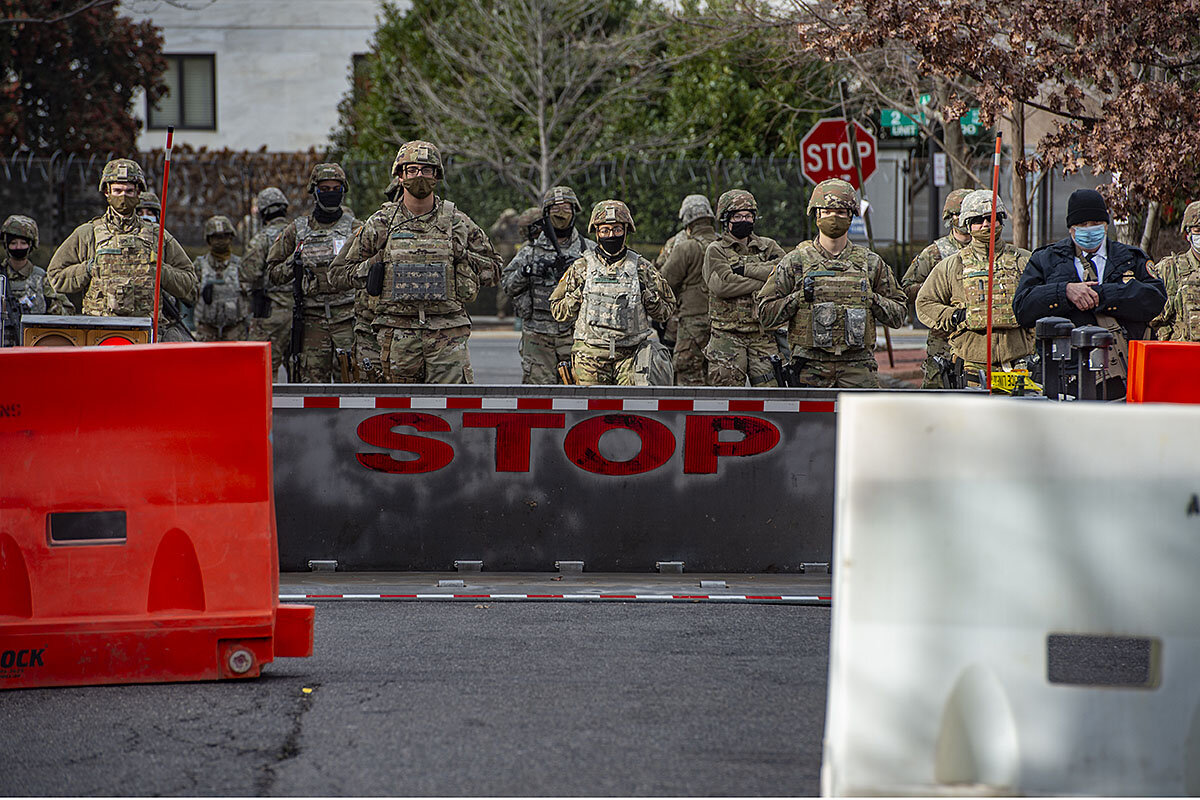
Yet Mr. Trump is as much a symptom as a cause, experts say, of the wrenching political realignment unfolding across America, similar to historic shifts during the antebellum period, the 1920s and ’30s, and the late 1960s, when the New Deal coalition crumbled. Such regroupings generate conflict and require unifying leadership – such as that promised by President Biden – to overcome.
This new era will call for “both political parties to spend more [when in power], if only to prevent social upheaval,” Professor Banerjee says. Reforms to electoral institutions may also be needed to bolster public confidence, he adds.
Steps for law enforcement
Much like after the shock of the 2001 terrorist attacks, the government may need to create an independent, bipartisan commission to provide a full accounting of the Jan. 6 insurrection at the Capitol and make recommendations for a comprehensive, intergovernmental response.
Law enforcement is likely to divert resources and manpower from fighting international to domestic terrorism, experts say. President Biden’s nominee for deputy attorney general, Lisa Monaco, has a counterterrorism background and would be well equipped to carry out such a pivot.
Partly this will require a policing of the police, since “you have some people in law enforcement who harbor some extremist views,” says Mary McCord, a former U.S. attorney in the Justice Department’s National Security Division who now teaches at Georgetown University Law Center.
“Those are challenges that this [Biden] administration, states, local governments, and everybody will have to respond to.”
Some argue a federal statute that specifically criminalizes “domestic terrorism” is necessary, to give domestic agencies more investigative powers and authorities, despite the existence of ample criminal laws that allow for such prosecutions, including state domestic terrorism laws.
“The fact we can charge somebody with a state crime for assault and murder isn’t the same as saying under federal criminal law that person is a terrorist,” says Chuck Rosenberg, an attorney and former senior FBI official. “There ought to be a moral equivalency between international and domestic terrorism.”
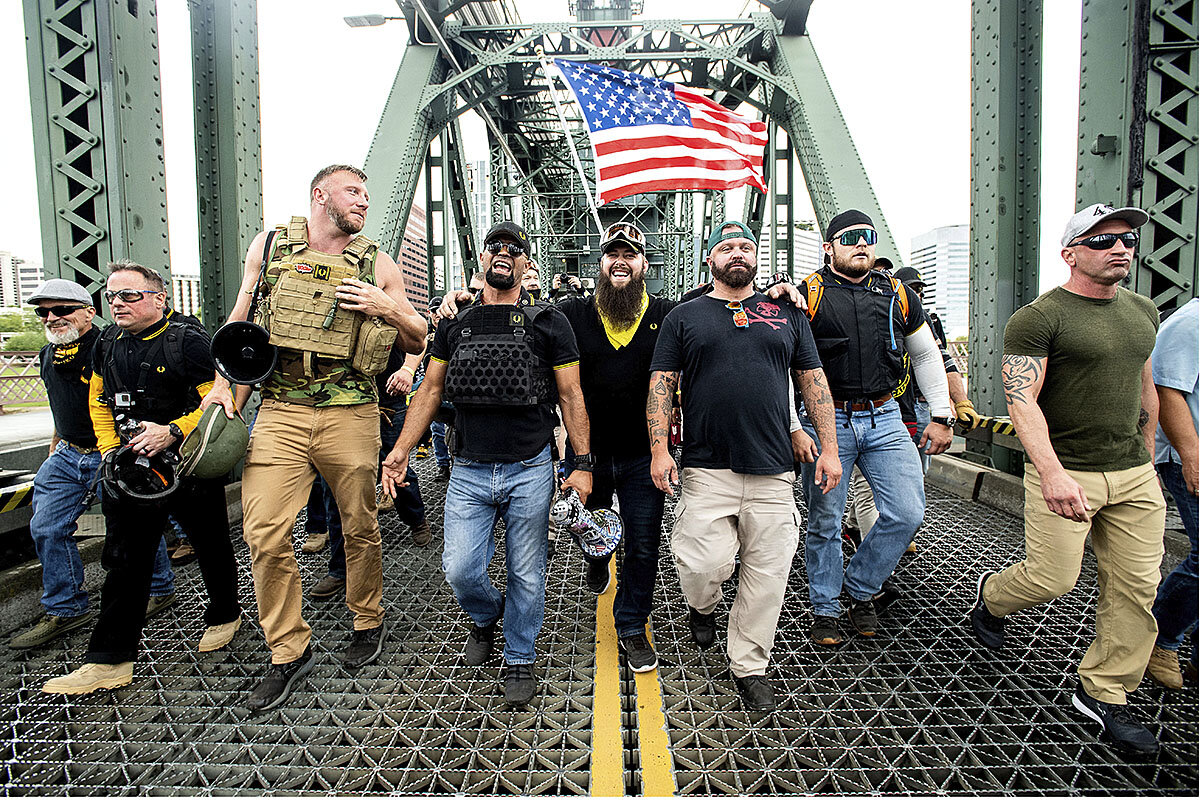
Critics say a federal terrorism statute is unnecessary and would create a constitutional minefield and potentially be open to abuse. “It’s a slippery slope once you start creating political crimes,” says David Gomez, a national security expert who spent 28 years at the FBI. “It’s a razor’s edge for the Bureau to walk,” agrees Todd K. Hulsey, a retired FBI supervisory special agent.
Tackling the spread of violent domestic extremism will, for example, force courts to wrestle with profound questions such as how much the open carry of weapons intimidates and chills speech and peaceful assembly.
“How do you meld gun rights laws with public protests, which are already tense affairs where people are agitated?” says Professor Zick, who is the author of a forthcoming book “Managed Dissent: The Law of Public Protest.” Gun-toting militias are transforming protest “into some kind of armed standoff,” he says. “Who wants to go and try to exercise their free speech rights in that context?”
The Supreme Court may have to take a merit-based Second Amendment case, which it has steadfastly avoided for over a decade, says Darrell Miller, a Duke University law professor and co-author of “The Positive Second Amendment.” “Justices can’t be ignorant of the fact of how guns are used publicly for good or ill,” says Dr. Miller.
Remember “the narrative that binds us”
In another striking sign of change, technology and social media companies such as Twitter, Facebook, and Amazon are taking far stronger measures to block or ban violent and dangerous content, steps some extremism experts say were long overdue.
Perhaps most important, the U.S. must address basic roots of unrest, namely the tribalism and polarization now deep-seated across society, including in the military, says counterinsurgency expert and retired Special Forces Lt. Col. Scott Mann, author of “Game Changers,” about defeating violent extremist groups overseas.
“I never in my life thought we would have this conversation about the United States of America,” he says. “We just held our breath, wondering if there will be a peaceful transition of power.”
Colonel Mann sees some similarities between group dynamics in the United States today and what he observed while deployed in Afghanistan, a status society where shame and honor prevail over social contracts and the rule of law.
“It’s hard for veterans to know how to live in a country that is tearing itself apart,” he reflects. “The level of contempt citizens are showing is a level normally reserved for one’s enemies.”
Still, Colonel Mann says, the United States has overcome such divisions in the past, such as after the Civil War, and can do so again by refocusing on a common narrative of resolving conflicts through discourse and the Constitution. Americans must remember “the narrative that binds us, who we are as a people,” he says. “That is what it will take for us to all stand shoulder to shoulder.”
Editor's note: This story has corrected Professor Javed Ali's former title. He was a senior director for counterterrorism at the National Security Council.

Afghanistan: Has Biden inherited defeat in America’s longest war?
The Biden administration appears caught between a Taliban rock and an Afghan hard place. The challenge, our reporter finds, is restoring some integrity to the peace process as soon as possible.
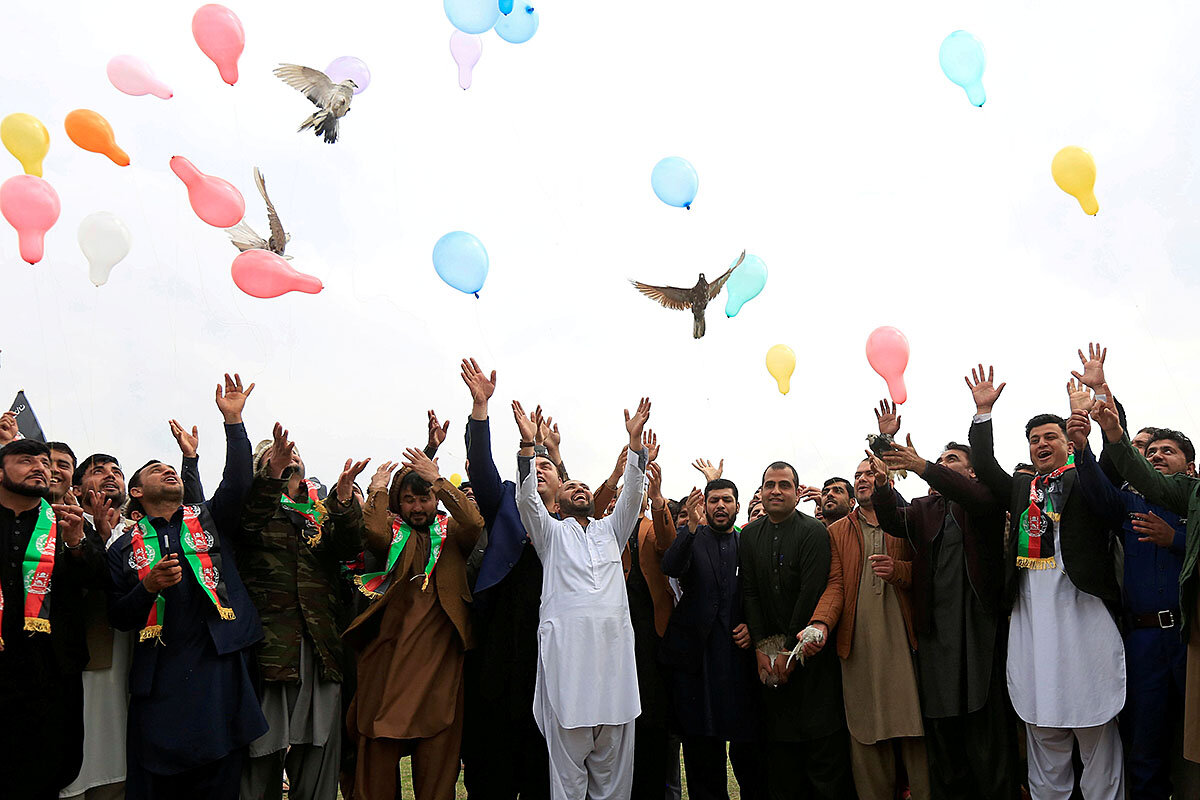
- Quick Read
- Deep Read ( 6 Min. )
President Joe Biden has called for an end to the “forever war” in Afghanistan. But questions are being raised about whether he has inherited a lose-lose situation in the form of a lopsided U.S. withdrawal deal that the Taliban are trumpeting as a victory.
Part of the challenge has been nearly a year of White House mishandling of its own policy. The Trump administration claim “that the U.S.-Taliban deal was grounded in conditionality was very publicly and obviously undone every time it made an announcement about unconditional troop drawdowns,” says analyst Andrew Watkins.
President Biden’s team hopes to find a way to end the war, but also to “retain some capacity to deal with any resurgence of terrorism, which brought us here in the first place,” Secretary of State Antony Blinken said.
Their dilemma: “The Taliban have now had almost an entire year to convince themselves ... of a particular interpretation of this deal,” says Mr. Watkins. “Their return to power – full stop.”
But, says a Western official in Kabul, the Taliban “are still at the table. That is why it is so important to reestablish confidence on both sides that this is a real peace process and not just a quick American fix.”
Afghanistan: Has Biden inherited defeat in America’s longest war?
With peace talks limping along and violence escalating across Afghanistan, the incoming Biden administration is vowing to “review” Taliban compliance with a withdrawal deal the United States signed last year with the Islamist insurgent group.
U.S. troop numbers are now at an all-time low in America’s longest war, after former President Donald Trump ordered a drawdown to just 2,500 on the eve of President Joe Biden’s inauguration.
But reaching that level, to be followed by a complete withdrawal of U.S. and NATO troops by May, according to the deal, was meant to be conditional on a Taliban reduction of violence, severing ties with Al Qaeda, and progress toward peace. None have occurred.
Like his predecessor, President Biden has called for an end to the “forever war” in Afghanistan. But the Taliban have surged attacks nationwide and have been the driving force behind a systematic assassination campaign that has killed dozens of journalists, women, and civil society activists in recent months.
And as the Taliban press their advantage on the battlefield and prepare for a bloody 2021 fighting season, questions are being raised about whether Mr. Biden has inherited a lose-lose situation, in the form of a lopsided deal that the Taliban are trumpeting as a victory that will return them to power.
Analysts say a diplomatic process that was rushed by the U.S. political calendar and a reactive dynamic on the ground, in which each side has constantly tested the other, without adhering to a strategy toward a cease-fire or peace, are to blame for the dire status quo.
“Biden has bad choices,” says Andrew Watkins, the senior Afghanistan analyst for the International Crisis Group. “Both actors are highly resistant to resetting their approach. Unfortunately, the way things progressed over the last year has built up just as much mistrust as at any point during this war.
“Because of the dynamics on the battlefield,” he continues, “there really is no possibility for the Biden team to have a solution that Biden – as vice president 10 years ago – once advocated for, which is to disengage from Afghanistan, but also leave a military footprint indefinitely, purely for the purpose of counterterrorism.”
Search for a middle way
Today such a solution is “not viable,” he adds, because it would prompt both an immediately intensified Taliban military campaign, and then impel any residual U.S. force to intervene on behalf of its strategic ally, the Afghan government, when it faced critical losses. That would leave the Americans in the same support role they have played for nearly two decades, but with far fewer resources.
Still, there are signs that Mr. Biden hopes to find such a middle way, according to his new secretary of state, Antony Blinken.
“We want to end this so-called forever war,” but also to “retain some capacity to deal with any resurgence of terrorism, which brought us here in the first place,” Mr. Blinken said at a Senate confirmation hearing last week.
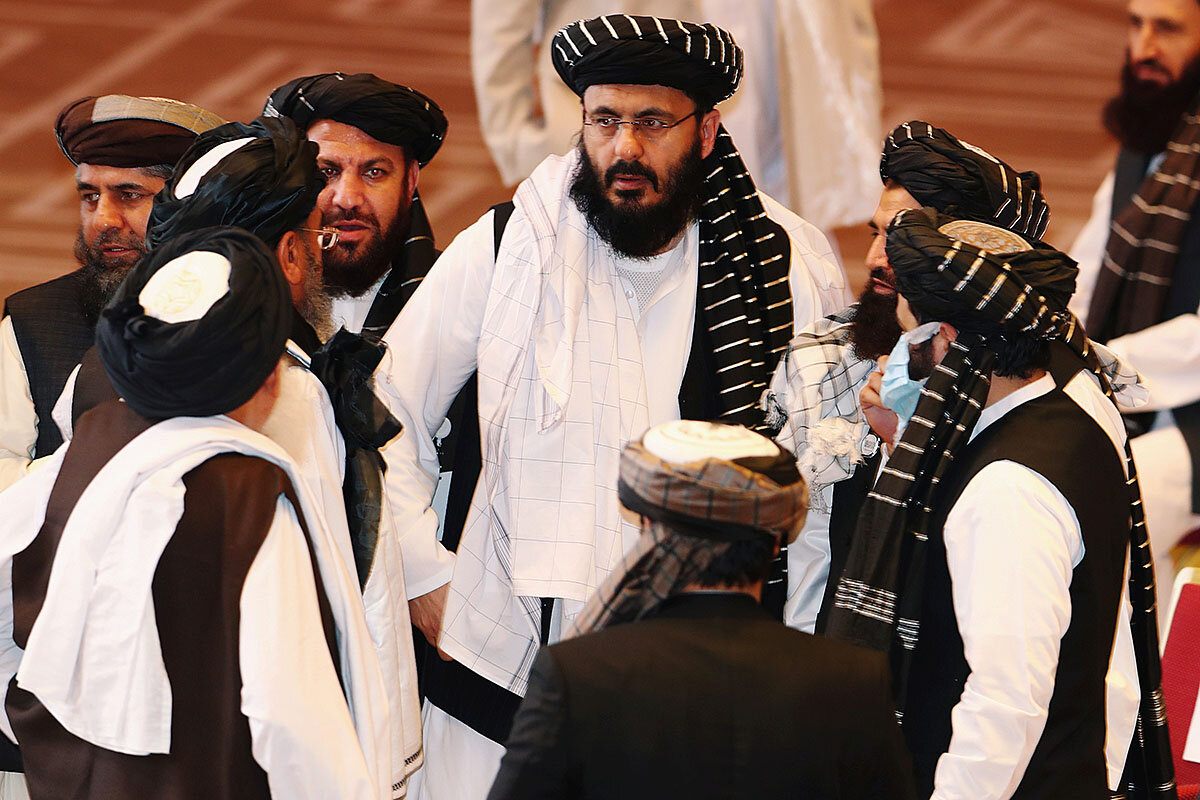
Jake Sullivan, Mr. Biden’s newly appointed national security adviser, told his Afghan counterpart, Hamdullah Mohib, on Friday that the U.S. review of Taliban compliance would determine whether the insurgents are living up to their “commitments” to cut ties with more radical jihadist groups, reduce violence, and engage in meaningful talks.
Yet part of the challenge has been the hardening, diverging expectations about the deal, enhanced by nearly a year of White House mishandling of its own policy by doing little to curb surging Taliban violence.
“The way the Trump administration claimed that the U.S.-Taliban deal was grounded in conditionality was very publicly and obviously undone every time that it made an announcement about unconditional troop drawdowns,” says Mr. Watkins.
“Even if the Biden team has an interest in turning this around and resetting the tone and tenor of these talks, and of the U.S.-Taliban relationship, it’s still going to face a dilemma, which is: The Taliban have now had almost an entire year to convince themselves and their fighters around the country of a particular interpretation of this deal,” adds Mr. Watkins. “They now believe that they know what the deal means, and what it was supposed to bring about, which is their return to power – full stop.”
“Everybody’s reacting here”
According to a Western security source in Afghanistan familiar with the events, U.S. moves during the past year have emboldened the Taliban, in fact, and at the same time angered Kabul. Exhibit A was the “muted” U.S. response to concerted, large-scale Taliban offensives against southern provincial capitals Lashkar Gah in October, and Kandahar in November, which required U.S. airstrikes to repel.
When the deal was signed last February, there was discussion about “secret annexes” that forbade Taliban attacks on provincial capitals. That gave way within months to a pattern of escalation that included attacks in Kabul and on key Afghan security force bases.
“Not to say that this is a highly centralized, thought-out plan,” says the security source. “Everybody’s reacting here. The Taliban are probing and pushing how much they can get away with; they don’t know what the American reaction is going to be to these different steps. Everybody involved is learning, and making it up as they go along. Each step informs the next one.”
Analysts say the haste with which the special U.S. envoy for Afghanistan, Zalmay Khalilzad, moved to make a deal with the Taliban – clearly pushing for concrete results before Election Day in November – resulted in a specific American withdrawal timeline, as demanded by the insurgents. In contrast, Taliban promises in exchange to prevent Afghan soil from being used to stage attacks abroad, and for mere participation in intra-Afghan peace talks, with a cease-fire agenda item only, not a requirement – were less tangible.
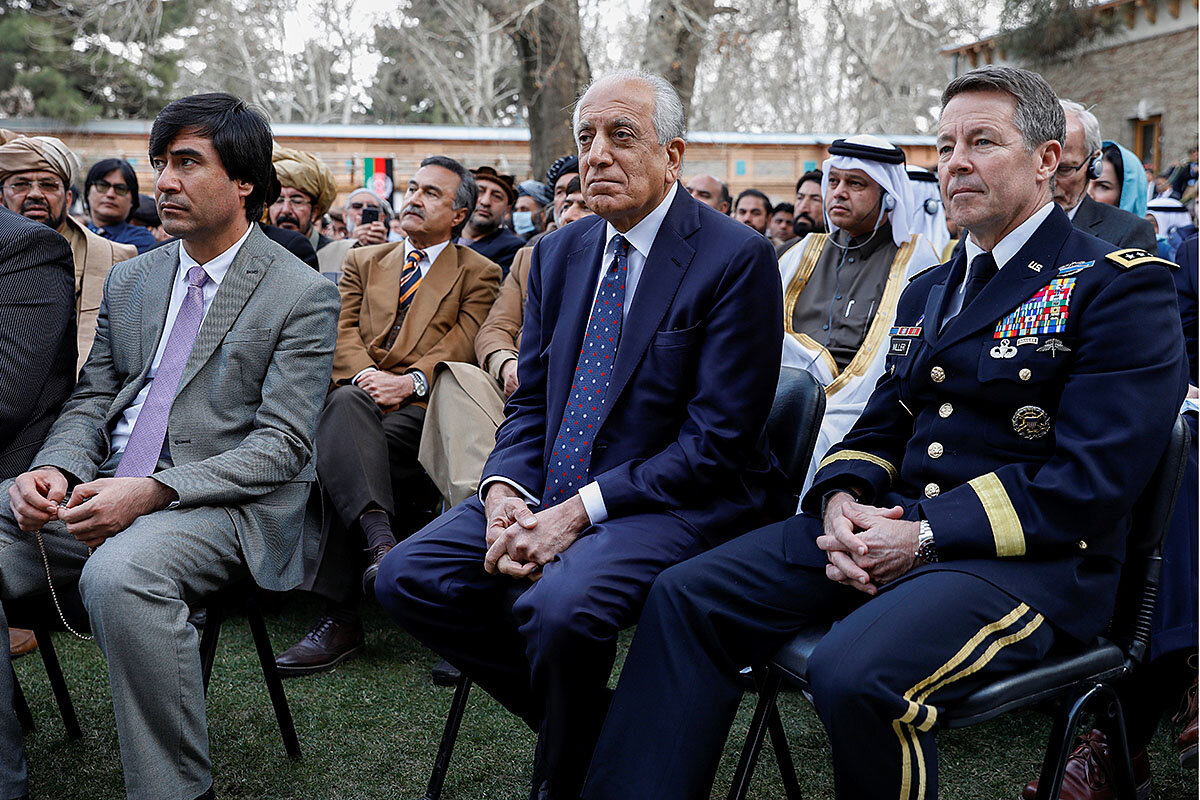
Even a Taliban commitment to reduce violence by up to 80%, as claimed by the U.S. military, was not publicly written down.
That result, and the overall light touch of the U.S. military and civilian leaders toward the Taliban, has raised questions about the utility of the White House taking a harder line, now. In one example, Mr. Trump telephoned Taliban co-founder Mullah Abdul Ghani Baradar just days after the deal was signed and hailed a “very good talk” in which they “agreed there is no violence.”
“The Americans have the airpower to strike the Taliban, whether they leave or not,” says the Western security source. “But the same question arises, as with [Lashkar Gah]: They can hit them with everything they got, but until when, and to what end? We can delay [withdrawal] several months, but again, to what end? Our options are severely limited, as a result of the process thus far.”
The security source adds: “The basic bottom line is that there is only one actor that has time on their side, and that’s the Talibs.”
Not just a quick fix
The deal has been portrayed by the Taliban leadership to their rank-and-file as the defeat both of a superpower and of its corrupt “puppet” regime in Kabul. That narrative makes it even more challenging for Mr. Biden to end the war on American terms, instead of on Taliban ones.
“The Taliban, ultimately in the short term they had to yield to the more conservative elements, to let them say ‘We’ve got to do these attacks, we’ve got to keep pushing,’” says a Western official in Kabul, who asked not to be named. That is “also so that the Biden administration looks at it, and says, ‘Oh, we can’t delay this much longer, these [Taliban] people mean business.’ That was one calculation.
“But ultimately I think they still want to get something out of the peace process,” says the Western official.
“They are still in Doha, they are still at the table,” the official says. “I think the tone will change in the negotiations, and it might be tougher [on the Taliban] in the short run. But that is why it is so important to reestablish confidence on both sides that this is a real peace process and not just a quick American fix to please Trump.”
Monday, President Ashraf Ghani greeted the U.S. review of the Taliban deal as a “new chapter” in its fraught ties with Washington.
“Ghani of course has great expectations of Biden that he is going to help more with the Taliban,” says the Western official. “But at the same time, I think Biden has very little appetite to continue a war that you can’t win.”

Teaching the Capitol riot is tricky. Especially if the teacher was there.
What happens when teachers aren’t just guides to civics and history, but also participants? We look at how some districts are responding as polarizing politics enter the classroom.

- Quick Read
- Deep Read ( 6 Min. )
Public school teachers have long guarded their constitutional rights to free expression, including when it involves their own government. But they are also held up as role models for their students. Nor are their free speech rights absolute if they lead to community disruption.
So the presence of teachers at the Jan. 6 rally for former President Donald Trump that led to the invasion of the Capitol has made ripples across the country. Some have been investigated over their actions after complaints from parents.
Questions have also been raised about teacher bias in classes leading up to Jan. 6, including the amplification of unfounded claims of electoral fraud. Similarly, school politics came to a head last summer over whether or not to embrace Black Lives Matter content in class.
“If you just went to D.C., attended the rally, came home, and weren’t involved in any activities at the Capitol building itself, it’s highly likely there’d be nothing that the school district could do – even if they disagreed with you,” says Jim Hanks, a retired education law attorney in West Des Moines, Iowa.
But many cases aren’t so neat as that.
If a public employee’s First Amendment activity “causes such disruption in a community that you are rendered ineffective as a teacher, you could lose your job,” says Mr. Hanks.
Teaching the Capitol riot is tricky. Especially if the teacher was there.

Paula Wilson’s children watched the Capitol siege unfold on TV from their Wisconsin living room, texting her updates as she worked an emergency room shift. When she got home, her son showed her a post from his 10th grade social studies teacher about his upcoming travel plans for Jan. 6.
Before he left town, the teacher, Jeff Taff, had assigned the class homework – and explained that he was headed to Washington for a few days.
“I am sorry, but standing up for election integrity and our right to vote in FAIR elections is too important for me to NOT be there,” he wrote, according to a photo of his post on Google Classroom.
“I couldn’t believe it,” says Ms. Wilson. “I was just thinking, he has a right to do whatever he wants, but why would he post this for all of his kids?”
The presence of school staff at or near the Capitol on Jan. 6 when a rally in support of former President Donald Trump led to violence has complicated the task of school districts across the country. Many have wrestled with convening class discussions about the polarizing events of that day while respecting employees’ political views and the political passions in the communities they serve. Some districts have been forced to consider disciplining personnel at a time when they’re also under sharp scrutiny from parents for their pandemic plans.
While teachers are held to a heightened standard as role models, they’re also “often held to a heightened standard as Americans,” says Janet Decker, associate professor at the Indiana University School of Education.
Some educators are unsurprised to see the nation’s fraught electoral politics crashing the classroom, stress-testing the role of educators as guides to civics and history.
“Every other controversy in our society that’s playing out appears in our public schools too,” says Tom Hutton, interim executive director of Education Law Association.
A district investigates
Ms. Wilson says her son’s revelations about Mr. Taff troubled her, so she reported her concerns to the school. An image of another Google Classroom post by the teacher appeared to link to a video about claims of widespread voter fraud.
Burlington Area School District has placed the teacher, whom it hasn’t named and who used personal days for his travels, on paid administrative leave pending an investigation. Legal experts say this is standard.
When the district posted a statement to its Facebook page Jan. 7, one user wrote that the district had no right to discipline the teacher. Another seemed displeased with the district’s “non-action approach.”
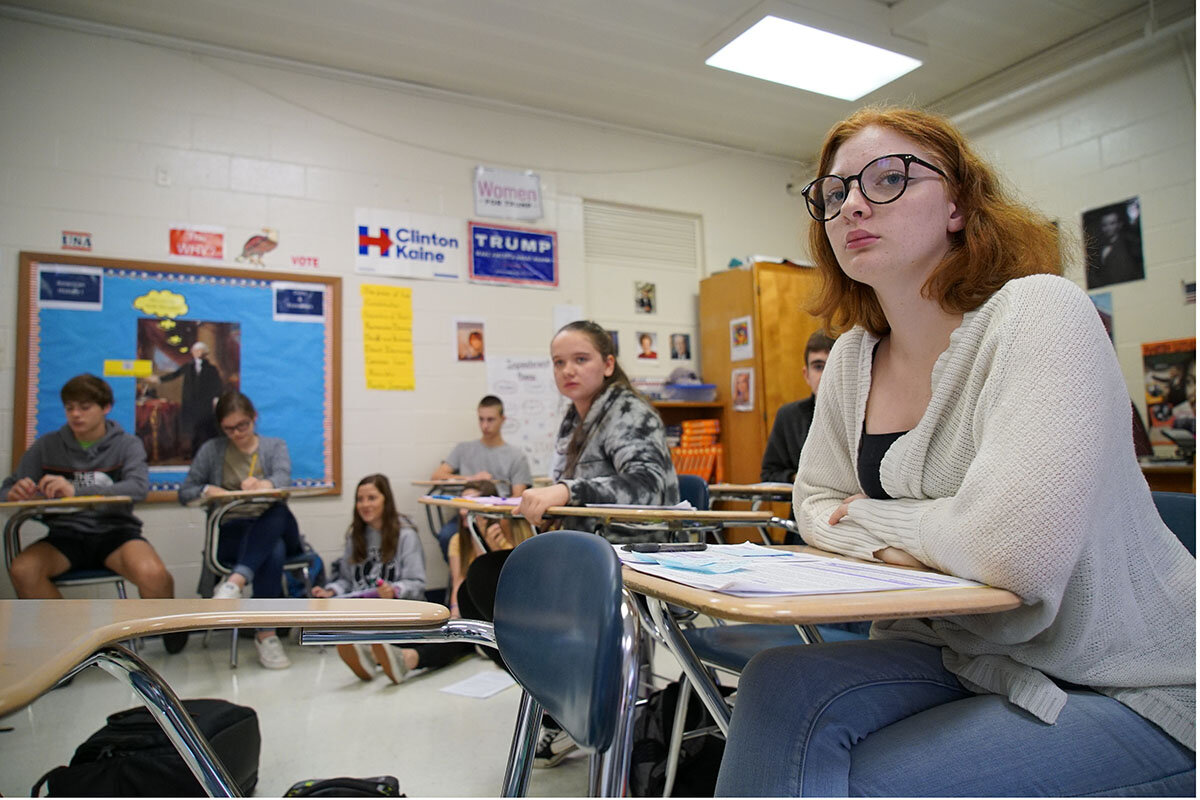
Meanwhile, the district investigation is widening its scope beyond an assignment posted to Google Classroom the week of Jan. 6, according to spokeswoman Julie Thomas.
In an email to the Monitor, Mr. Taff’s attorney, Todd Terry, said the teacher prioritizes his students’ education. He added that his client is cooperating with the investigation while defending himself against “misinformation, venom and outright lies.”
Ms. Wilson, the 10th grader’s mom, says she has broader concerns than the initial Google Classroom post. She says the family has reported other allegations of politicized remarks made by the teacher during class.
Responding to a question about how districts can engage constructively with their communities during a time of political polarization, Ms. Thomas said via email that schools can create “a safe place to learn.”
“We encourage our students and staff to be kind,” she wrote.
Ms. Wilson’s fiance, Jon Phetteplace, was met with less than kindness after speaking out. The Burlington native began receiving online threats after publicly questioning Mr. Taff’s instruction. “It really doesn’t make us want to be part of the community anymore,” he says.
First Amendment rights?
Educators aren’t the only ones facing fallout from Jan. 6. Since the pro-Trump march devolved into a siege that left five dead, private and public employers countrywide have investigated and disciplined staff for potential wrongdoing.
School district employees in Pennsylvania, Arkansas, California, and elsewhere have drawn scrutiny for their attendance. Some have publicly pushed back, including two bus drivers who sued a West Virginia superintendent after they were placed on paid leave.
Last summer’s mostly peaceful racial justice demonstrations also became a flashpoint for divisive politics in U.S. schools. A Texas public school teacher was placed on paid leave for hanging Black Lives Matter and LGBTQ posters in her classroom. In Vermont, a public school principal was fired for Facebook comments related to the Black Lives Matter movement, which the school board found to be derogatory against African Americans.
Legal experts say public employees’ First Amendment rights are typically protected – unless they were found breaking the law.
“If you just went to DC, attended the rally, came home, and weren’t involved in any activities at the Capitol building itself, it’s highly likely there’d be nothing that the school district could do – even if they disagreed with you,” says Jim Hanks, a retired education law attorney in West Des Moines, Iowa.
But some may have done more than that. So far, at least one educator faces criminal charges linked to the Capitol siege.
A former school occupational therapist from Ohio, Christine Priola was arrested and charged in federal court this month for unlawful activities at the Capitol. Social media users helped law enforcement identify her in photos from Jan. 6, when she allegedly appeared inside the Senate chamber with a sign spelled in red: THE CHILDREN CRY OUT FOR JUSTICE.
The following day, Ms. Priola sent a resignation letter to Cleveland Metropolitan School District that noted her plans to “expose the global evil of human trafficking and pedophilia” allegedly in the government – echoing QAnon conspiracy theories. Ms. Priola did not respond to requests for comment.
Blowback in the community
Other factors complicate public school staff members’ rights. In a case involving a California state prosecutor, the Supreme Court ruled in 2006 that public employees’ speech is limited when made “pursuant to their official duties.”
For districts weighing how to respond to what teachers do outside class, public blowback adds another twist. If a public employee’s First Amendment activity “causes such disruption in a community that you are rendered ineffective as a teacher, you could lose your job” or face other discipline, says Mr. Hanks.
For Jason Berry, an elementary school P.E. teacher in Harrisburg, Pennsylvania, his presence at the Jan. 6 protests put him in an uncomfortable spotlight. But after his employer, the Susquehanna Township School District, investigated him, it said his actions didn’t violate their policy – and were protected by the First Amendment.
Mr. Berry says he’s grateful that he’s been cleared to keep teaching. “Susquehanna did a wonderful job and looked at the facts,” he says.
Mr. Berry maintains that he did not engage in the Capitol violence, and the district confirmed it had approved his personal day off. That day, a Christian TV network showed a video of him and his friends praying and worshipping at the rally. In the clip, Mr. Berry wears a Trump hat. A photo of the clip was then passed around social media out of context, he says.
A community member began an online petition Jan. 6 that called for Mr. Berry’s removal, pointing him out among “other maskless insurrectionists.” It garnered over 5,000 supporters. A week later, the petition organizers clarified in a post that there was “no current evidence” to substantiate that the teacher was violent or stormed the Capitol.
Mr. Berry says he was religiously – not politically – motivated to drive to Washington with church friends Jan. 6. He says he went to pray for the nation. “It was a day when a lot of different decisions would be made, and so I thought it was a great opportunity to come up with believers and pray for the United States,” says Mr. Berry, who is Christian.
Mr. Berry says he’s moving on from the attack on his beliefs: “I chose to forgive them.”
In a Jan. 11 video, Susquehanna superintendent Tamara Willis condemned the Capitol violence and said she welcomed the public’s concerns raised by the investigation.
“I am charged with making decisions for this school district in all of its diversity based upon evidence, even when emotions are running high and public opinion seemingly pressures us to do otherwise,” she said.
Educators shouldn’t shy away from teaching these events, says Professor Decker from Indiana University.
“We need more civics education, not only for teachers and school employees, but also for students, so that people understand the limitations to their freedom of speech rights,” she says.

Patterns
World wonders whether Biden has enough bandwidth for it
You might assume that Washington has too much on its plate at home to lead on global issues. But it’s not necessarily one or the other, our London columnist observes. Leading by example can mean tackling the U.S. pandemic and a fractious democracy.

- Quick Read
- Deep Read ( 4 Min. )
-
By Ned Temko Correspondent
President Biden has pledged to reclaim and redefine America’s place in the world, and he seems to have three options before him, which could be characterized as “Go Big,” “Lie Low,” and “Steady the Ship.”
Going Big would mean energetically reasserting American global leadership. That jibes with Mr. Biden’s instincts, but he has so much to do at home that he may not have the bandwidth to “go big” internationally.
Lying Low might seem tempting, but even if the new administration wanted to put the world on hold, the world won’t do the same to America. Issues demanding Washington’s attention will keep cropping up.
So Steadying the Ship appears the most likely course for now. But Washington’s success in re-engaging the world could depend on what happens at home. The last four years have raised questions about U.S. reliability. Now, Mr. Biden said in his inaugural speech, America must lead “not merely by the example of our power, but by the power of our example.”
World wonders whether Biden has enough bandwidth for it

“The world is watching.” The words, spoken by U.S. President Joe Biden in last week’s inaugural address, were true. But they told only half the story: The world wasn’t just watching, it was wondering.
Amid the daunting domestic challenges President Biden faces, America’s friends and foes alike were wondering the same thing: How quickly and decisively would he, or could he, fulfill his pledge to reclaim and redefine America’s place in the world?
In other words, which of three menu options would guide the president and his foreign policy team?
Would they click on Go Big?
Lie Low?
Or Steady the Ship?
Each offers temptations. Each also holds pitfalls. But – spoiler alert – the balance of risk and reward is making one of them likeliest, at least for the near future.
Go Big would mean not only reconnecting with allies and international organizations shunned by former President Donald Trump, but energetically reasserting American leadership. This jibes with Mr. Biden’s own deeply held view of the U.S. as a key voice in tackling international challenges, safeguarding global stability, and advancing the shared interests of democratic allies.
The new president has been nodding in this direction since the day he took office, especially when it comes to topics he has characterized as “tomorrow’s challenges,” such as climate change and dealing both with COVID-19 and potential future pandemics.
In announcing his administration was rejoining the Paris climate accords and the World Health Organization on Day One, he clearly meant for the U.S. to do more than just make up the numbers. After all, he has named a “climate envoy” to his cabinet: John Kerry, the former secretary of state who affixed America’s signature to the Paris Agreement.
Some, however, would like him to go further. One of Mr. Biden’s friends, former British Prime Minister Gordon Brown, is urging the president to propose a special summit of the G-20 group of leading world economies to spearhead “emergency global action” on climate change and the interlocking health and economic crisis caused by the pandemic.
He also wants the Biden administration, along with Europe, to stump up the $30 billion needed to ensure COVID-19 vaccinations for the entire world.
Will all that happen? It is possible. Yet given the enormous scale of the domestic tests Mr. Biden has set himself – curbing the pandemic, rescuing the economy, and healing a bitterly divided nation – the administration may lack the bandwidth to “go big” internationally.
That’s why Menu Option 2 – Lie Low – might seem enticing. In essence, it would limit early foreign policy moves to basic reengagement and patching up frayed alliances, while deferring broader action until Mr. Biden has made a significant dent in his to-do list at home.
But there’s one huge impediment to lying low, which pretty much rules that option out.
Just in his first week in office, the president has had to consider a raft of real-world issues, ranging from provocative flights by Chinese jets near Taiwan and widespread street protests in Russia to a refugee caravan heading toward the southern U.S. border. Plus, the last surviving arms control agreement between the U.S. and Russia is due to expire early next month.
The administration may see advantages in putting the outside world on hold.
But the world isn’t going to put America on hold.
So, on balance, the third option – Steady the Ship – would seem most likely, at least for now. That doesn’t imply doing nothing. It has already meant rejoining Paris and the WHO, as well as signaling support for a five-year extension of the New START arms accord with Moscow. At the same time, the administration has taken a stern line on Russia’s arrest of opposition politician Alexei Navalny and of protesters who turned out to support him, as well as announcing a review of Washington’s strategy toward Beijing, declaring that China had become “more authoritarian at home, and more assertive abroad.”
The president, Secretary of State Antony Blinken, and national security aides will be busy talking to key allies on all these issues in the coming weeks. They’ll also be working to define a post-Trumpian approach to a pair of especially thorny challenges: a nuclear-armed North Korea and an Iranian regime drawing ever closer to its own nuclear capability.
Yet how successful Washington will be in re-engaging the world, whichever option it chooses, could still depend on what happens at home.
The past four years haven’t just damaged U.S. alliances overseas, raising questions about America’s reliability as a partner.
The virtually unchecked spread of the pandemic in the U.S., the assault on the Capitol challenging the results of the presidential election, and continuing evidence of deep anger and political divisions – all these have badly tainted America’s image as the world’s exemplary, stable democracy.
Another line from Mr. Biden’s inaugural speech, which was not just lofty rhetoric but trenchantly accurate, summed up the challenge that implies.
America, he said, must be able to lead “not merely by the example of our power, but by the power of our example.”

Difference-maker
San Antonio educator: College-ready kids make poverty-proof adults
The road to economic freedom often starts with a college degree. We look at how Pedro Martinez is helping students and parents overcome obstacles on this journey.
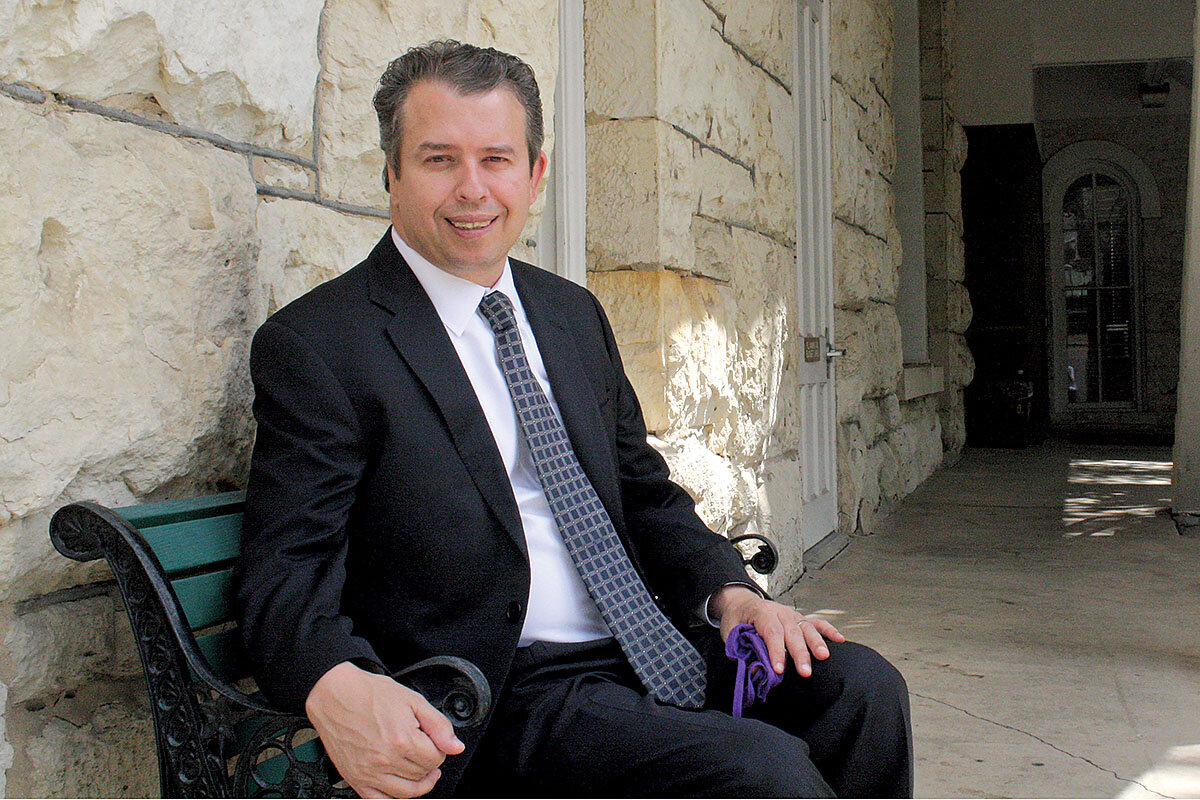
- Quick Read
- Deep Read ( 6 Min. )
When Pedro Martinez graduated from high school in 1987 in Chicago, where the dropout rate was 43%, his senior class had dwindled to just 171 – down from 700 his freshman year.
“Throughout my career, including here [in San Antonio], that is my lens,” says Mr. Martinez, now superintendent of the San Antonio Independent School District. “I have seen personally that education is our best vehicle to help families deal with issues of poverty. In today’s world, if you don’t have [a college degree], you’re not going to have a living-wage job, you’re not going to be able to support a family [or] to be independent.”
An intense focus on improving academic achievement and preparing students to get into, and stay in, college is a core aspect of how Mr. Martinez is improving the high-poverty, largely Hispanic school district.
His analytics-heavy, private sector-friendly approach to charters and to partnerships with both businesses and foundations is not without critics, but his programs have increased college readiness – as defined by the Texas Education Agency – from 45% of graduates in 2017 to 66% in 2020. In four of the past five years, more than half the district’s graduates have enrolled in college within a year – above the state average.
San Antonio educator: College-ready kids make poverty-proof adults
After years of hard work, Maria García-García’s dream finally came true last year: The Young Women’s Leadership Academy senior won a full scholarship to the Massachusetts Institute of Technology to study engineering. But then she faced perhaps the toughest part of the process: convincing her mother to let her eldest child leave home and move so far away.
Enter Pedro Martinez, the superintendent of the San Antonio Independent School District (SAISD), who’d faced a similar hurdle in his route to higher education. Like Ms. García-García, Mr. Martinez was the oldest child in a large, low-income family, and the first to want to go to college: His father was against it, and Mr. Martinez felt guilty about putting his education ahead of his family who needed him to help make ends meet.
“[He] really helped me to see that this wasn’t the first time someone was in a situation like this,” says Ms. García-García, of her conversation with Mr. Martinez at her school last January.
The district went into overdrive to build her mother’s trust in the system. Teachers and principals talked to her mom, assuring her MIT would have people her daughter could turn to with any issue. SAISD would stay in touch with its graduate at MIT by phone. Mr. Martinez’s wife had friends in the Boston area who could help in emergencies.
Her mother came around, she says, “because I was getting all this support she didn’t expect me to have.”
Ms. García-García’s story exemplifies the struggles and successes of Mr. Martinez’s college initiatives at SAISD.
“Unless they’ve been through college, it’s very difficult for families to really help and guide their children,” says Mr. Martinez. It “is just a normal fear of the unknown. Many of these families have never left San Antonio, so even to go to [the University of Texas at] Austin, which is only an hour and a half away, it’s a different world for them.”
But, he adds, “I have seen personally that education is our best vehicle to help families deal with issues of poverty. In today’s world, if you don’t have [a college degree], you’re not going to have a living-wage job, you’re not going to be able to support a family [or] to be independent.”
An intense focus on improving academic achievement and preparing students to get into, and stay in, college is a core aspect of how Mr. Martinez is trying to improve the high-poverty school district. His analytics-heavy, private-sector-friendly approach to charters and to partnerships with both businesses and foundations is not without critics: Some believe they marginalize community influence and don’t do enough for students who can’t make those academic achievements. But on college readiness, in particular, he has helped deliver marked improvements.
Shirley Gonzales, a city councilwoman from San Antonio’s downtown west side, credits Mr. Martinez’s strong leadership for much of the success. She credits him for the “very quick results” in student achievement, as well as for a grander vision for the district. When the district was putting forward a successful $1.3 billion bond vote for campus building improvements, she recalls him saying, “Our buildings should not reflect the poverty of our community.”
The roughly 48,000-student, predominantly Hispanic district covers San Antonio’s urban core. Almost 90% of its students are economically disadvantaged, and more than half are from single-parent households.
“Armor” for students
Mr. Martinez says his college readiness focus aims to give students “armor” to survive the intensity of college.
This district covered the cost for students to retake the SAT and ACT to improve scores – 42% got “college ready” test scores this year, compared with 25% in 2017. It organizes college visits nationwide for juniors and seniors, and signed agreements with local universities guaranteeing scholarships for a certain number of SAISD graduates.
The district worked with parents to send personalized care packages to graduates at college – like the bundle of pens, highlighters, a notebook, and chocolate pretzels to 2019 graduate Emmanuel Mendez at Northeastern University in Boston. It is building networks of alumni to support graduates at out-of-state schools, and there are two full-time employees whose only job is to check on recent graduates now in college.
Statistically, SAISD college readiness – as defined by the Texas Education Agency – has increased from 45% of 2017 graduates to 66% in 2020. The value of scholarships won by students has increased from $51 million in 2015 to $99 million last year. In four of the past five years, more than half the district’s graduates enrolled in college within a year – above the state average.
Critics of his reforms say the focus should be less on the superintendent’s childhood and more on his career since then – in particular, his lack of classroom experience and his time at the Broad Academy, a program that trains aspiring education leaders, and has been criticized as too open to private-sector influence on public education.
“Throughout his tenure, he’s made a number of decisions that really take the voice away from the people within a community,” says Alejandra Lopez, president of the San Antonio Alliance of Teachers and Support Personnel, the SAISD employee union. She points to the district’s 2018 decision to let Stewart Elementary School be taken over by a New York-based charter school company in a 10-year contract with the private company to operate the school. Ms. Lopez was a second grade teacher at Stewart, but left because of the takeover.
She argues that Mr. Martinez’s understanding of the district comes from “a very deficit-minded place,” overlooking other models and metrics for student success and reinforcing negative perceptions of communities in the district.
“It perpetuates the mindset that you have to escape your surroundings,” she adds. “We want our students to value themselves and their community and work together to improve our conditions as a whole.”
Mr. Martinez, however, believes that doing everything he can to help his students get college degrees helps the community. He points to the economic damage caused by the COVID-19 pandemic, which has disproportionately harmed American workers without higher education. “At the end of the day ... you need a degree,” he says.
The Chicago lens
Many parents see the difference he makes, says Yesenia Alvarez-Gonzalez, an SAISD parent and chief program officer of Avance San Antonio, a nonprofit improving access to early childhood education for low-income residents. “The communication, the involvement, the interest he has, has been significant,” she says.
When Mr. Martinez graduated from high school in 1987, the dropout rate in Chicago Public Schools was around 43%. Half of the city’s high schools ranked in the bottom 5% in the country on the ACT.
His freshman class had 700 students, and as students dropped out, that dwindled to 171 his senior year.
“To this day, it still angers me,” he says. “Throughout my career, including here [in San Antonio], that is my lens.”
After graduating from the University of Illinois, Urbana-Champaign with majors in accounting and finance, he was director of finance for the Archdiocese of Chicago. In 2003 he became chief financial officer for Chicago Public Schools, working under future U.S. Education Secretary Arne Duncan.
“The combination of being great on the financial side, but really, really understanding our city and our kids in a way few can,” says Mr. Duncan, “that’s what made him an invaluable part of our team.”
He attributes his college initiatives success to a Valero Foundation grant. A $50,000 gift from the San Antonio Area Foundation and Wells Fargo, this funded increased access to technology and the internet for students. The Alamo Colleges District, a community college network, assumed management of three district high schools in November as part of efforts to improve college readiness.
While acknowledging he doesn’t have much classroom experience, he notes that his business background has enabled him to attract business support that can fund the best hires, which make his programs work.
Other headline stories we’re watching
(Get live updates throughout the day.)The Monitor's View
Redefining US leadership with foreign aid
- Quick Read
- Deep Read ( 3 Min. )
-
By the Monitor's Editorial Board
President Joe Biden plans to renew American leadership in the world, and the centerpiece of his foreign policy will be aid for less-well-off countries. That means, for example, more money for empowering women and building democratic institutions in what is called the global south.
Yet this well-intentioned effort in Washington must also deal with a trend among Western-based aid organizations. Their work now entails listening more to local recipients of aid rather than operating mostly from the priorities of private donors and wealthy countries. They have moved jobs and offices to the countries where they focus their work.
In other words, motives for foreign aid are under heightened scrutiny. Strategic interests of aid givers still matter, but so now does humility. More aid starts by letting the people on the receiving end build a consensus around the values and goals of a program meant to help them.
While the people of the global south welcome foreign assistance, they have grown impatient with being passive recipients. The most effective programs now build in mutual respect and partnership. American leadership, with aid as its focus, may need to rethink who is doing the leading.
Redefining US leadership with foreign aid

President Joe Biden plans to renew American leadership in the world and the centerpiece of his foreign policy, according to Secretary of State Antony Blinken, will be aid for less-well-off countries. That means, for example, more money for empowering women and building democratic institutions in what is called the global south. Mr. Biden has appointed a woman, Samantha Power, as administrator of the U.S. Agency for International Development (USAID). She is well known for promoting equality and the protection of individual rights. And, in a first, she will be an official member of the president’s National Security Council.
Yet this well-intentioned effort in Washington must also deal with a trend among Western-based aid organizations like Oxfam and Amnesty International. Their work now entails listening more to local recipients of aid rather than operating mostly from the priorities of private donors and wealthy countries. They have moved jobs and offices to the countries where they focus their work. They are putting more emphasis on hiring locally.
In other words, motives for foreign aid are under heightened scrutiny. Strategic interests of aid givers still matter, but so now does humility. Leadership itself is being redefined. More aid starts by letting the people on the receiving end build a consensus around the values and goals of a program meant to help them.
Numbers illustrate what is driving change. Only 2.1% of global development funding goes directly to local civil society organizations, according to the U.N. Office for the Coordination of Humanitarian Affairs. The rest is allocated through international organizations to local partners. Because 99.1% of nongovernmental organizations in the global south function as subcontractors, they have little or no say in how projects are designed. Eight wealthy governments and private philanthropic entities account for nearly 90% of all development aid.
One critic of the traditional Western approach is Nigerian-American novelist Teju Cole. Writing in The Atlantic, he neatly summarized the frustration of aid “recipients”: “How, for example, could a well-meaning American ‘help’ a place like Uganda today? It begins, I believe, with some humility with regards to the people in those places. It begins with some respect for the agency of the people in Uganda in their own lives.”
Two projects in Zimbabwe underscore how Western and local development groups approach the same problem differently.
Twenty years ago then-President Robert Mugabe incited violent attacks on the country’s commercial farms. The few thousand owners, most of whom were white, scattered to Zambia, Angola, and Australia. Their farms, the most productive in Africa, were taken by government ministers or appropriated by ragtag small farmers who had no seed or farming equipment. Food shortages drove more than a quarter of the population into neighboring countries.
But almost immediately, some of the new aspiring farmers joined with environmentalists and social justice activists to form an “agroecology” organization to build capacity and protect the rights of female growers. Today the Zimbabwe Smallholder Organic Farmers Forum is an internationally recognized group with 19,000 members. It is sustained by a network of small donors worldwide.
Speaking with La Via Campesina, an international advocacy group, Thandiwe Chidavarume, of the Rural Women’s Assembly in Zimbabwe, offered a perspective of what agriculture development means locally: “Rural women farmers demand climate justice, participation in decision-making, and recognition of their immense contribution to food security and food sovereignty.”
By contrast, USAID launched a “farmer to farmer” program with the government of Zimbabwe in 2018 to provide “technical assistance by highly qualified American volunteers.” Its reliance on external expertise is matched by external goals. In announcing its project, USAID said the program would “increase understanding of ... US development programs.”
While the people of the global south welcome foreign assistance, they have grown impatient with being passive recipients. The most effective programs now build in mutual respect and partnership. And some countries that have long received aid, such as Bangladesh, now have their own aid groups working overseas. American leadership, with aid as its focus, may need to rethink who is doing the leading.

A Christian Science Perspective
Each weekday, the Monitor includes one clearly labeled religious article offering spiritual insight on contemporary issues, including the news. The publication – in its various forms – is produced for anyone who cares about the progress of the human endeavor around the world and seeks news reported with compassion, intelligence, and an essentially constructive lens. For many, that caring has religious roots. For many, it does not. The Monitor has always embraced both audiences. The Monitor is owned by a church – The First Church of Christ, Scientist, in Boston – whose founder was concerned with both the state of the world and the quality of available news.
‘You have no power over me’
- Quick Read
- Read or Listen ( 3 Min. )
-
By Evan Mehlenbacher
At times, evil – such as sickness, gloom, or animosity – can seem inevitable. But facing it from the standpoint of God’s nature as endlessly good equips us to disarm evil and experience more fully our God-given health, happiness, and peace.
‘You have no power over me’
One day I found my home in anguish. The children were complaining, one of them was ill, my wife was too, the mood in the home was gloomy, and I was depressed. I prayed for each individual’s recovery, but with no success.
Then I changed the focus of my prayers. Instead of praying for the recovery of certain family members, I prayed more broadly to understand God’s ever-present and unassailable control over our home. And I began to realize that God, good, was the only legitimate influence over our collective health and well-being.
The effect was dramatic. Gloom lifted and sickness vanished in short order.
I learned a valuable lesson from this experience – namely, that trouble is not always what it appears to be. If a child is feeling sick because he fears facing a bully, the root issue is not the sickness. It’s fear. To succeed in spiritual healing, we have to face the “bully.”
Mary Baker Eddy, the discoverer of Christian Science, coined a phrase to define the bullying effect of evil. She called it “malicious animal magnetism.” It designates the multitude of ways, whether hidden or overt, that would stop health, life, and peace from being the norm.
As ominous as this bully may seem, it is not a power to fear. It’s something to be exposed and proved illegitimate, for God’s goodness and love are limitless and eternal.
Jesus Christ faced the untiring malice of those who were jealous, envious, and afraid of the impact of his healing ministry. They were constantly plotting his demise. But Jesus was not afraid of his adversaries. He knew that his life was preserved forever in divine Spirit. The Bible shows how Jesus faced all forms of evil with the same attitude: “You have no power over me.” The credibility of this stance was immortalized when he walked out of the tomb alive after his crucifixion.
Mary Baker Eddy faced malicious threats when she presented Christian Science to the world. But she learned not to fear evil, but to face it straight on and neutralize it through the all-powerful divine Love, God, she worshiped.
One time a would-be assassin slipped into her room. She recounted that before he entered, she became aware of impending danger and at first thought she should lock her door. But she decided cowering in fear wasn’t a permanent solution. She left the door open. The man entered the room, pointed a gun at her, and was met with a response of “You cannot shoot.” His arm became useless, as though paralyzed, and he left. His evil intent was instantly disarmed (see Yvonne Caché von Fettweis and Robert Townsend Warneck, “Mary Baker Eddy: Christian Healer,” Amplified Edition, p. 301).
Mrs. Eddy didn’t ignore the man or pretend that he didn’t exist. She faced her foe with absolute confidence in the power of Love to protect her and stop him. She took the right steps and won a victory for righteousness.
The notion that evil has valid power must be fearlessly countered, not ignored. “There is nothing covered, that shall not be revealed,” Jesus promised (Luke 12:2). Evil is not a counter-power to God. Within God, the divine Mind, there are no destructive powers or influences. All is good. Understanding, even just a little, God’s nature as ever-present good empowers us to realize and experience a fuller freedom, safety, and peace.
In “Science and Health with Key to the Scriptures,” Mrs. Eddy wrote, “To infinite, ever-present Love, all is Love, and there is no error, no sin, sickness, nor death. Against Love, the dragon warreth not long, for he is killed by the divine Principle. Truth and Love prevail against the dragon because the dragon cannot war with them” (p. 567). Malicious animal magnetism is the dragon that divine Truth and Love prove powerless. Armed with divine Truth, each of us can fearlessly face the dragon, in whatever form it may take, with the conviction, “You have no power over me!”
Adapted from an article published in the November 2011 issue of The Christian Science Journal.
Some more great ideas! To read or share an article for teenagers about the healing power of God’s good thoughts titled “Healed of depression,” please click through to the TeenConnect section of www.JSH-Online.com. There is no paywall for this content.

A message of love
Tracks of tears
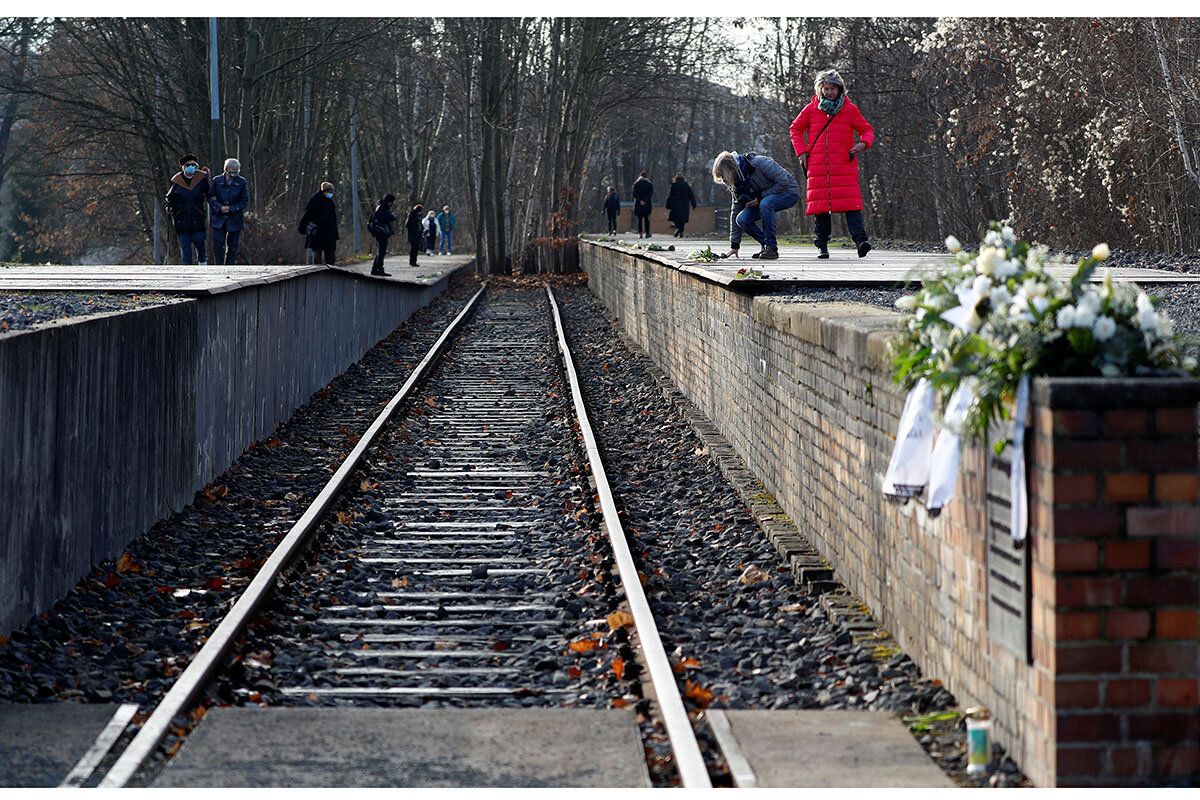
A look ahead
Thanks for joining us. Come back tomorrow: We’re working on a story about what the goal of greater “unity” in America means when applied to a divided Congress.
If you missed yesterday’s webinar, “Healing racial injustice. How news can help bring us together,” here’s a video replay. It features Monitor Editor Mark Sappenfield, and reporters Samantha Laine Perfas and Jessica Mendoza.



